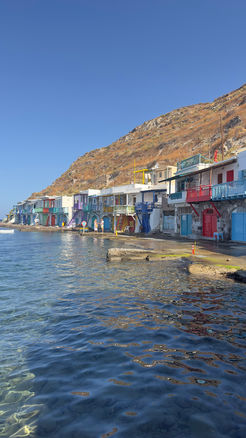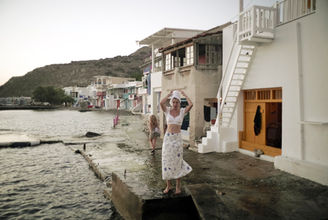
September 16, 2025 | VOL 16
MILOS, in SLOW MOTION
words Nicolas Vamvouklis
photos 1-Courtesy Domes White Coast Milos, 2-Onur Basturk, 3-Emre Doğru
There’s an island in the Cyclades where the landscape resembles sculpture, the sea turns turquoise in unexpected coves, and the food tells stories of salt, earth, and sun. Milos is not just beautiful—it feels self-authored, as if shaped by nature with a designer’s eye.
Lying quietly in the Aegean, Milos has slowly become a discreet magnet for those in search of elemental luxury. Artists, architects, and travelers with a taste for the unpolished are now coming here not only for the beaches, but for the feeling—of openness, of texture, of something rare.
The island is shaped like a horseshoe, its topography defined by its volcanic origin. This geological past has endowed Milos with mineral-rich cliffs, soft sandy arcs, and rock formations that flirt with abstraction. What sets it apart is its refusal to be flashy. It doesn’t overperform. It simply is—and that is its greatest seduction.

THE SHAPE OF A PLACE
Your introduction to Milos will likely be Adamas (or Adamantas), the main port. The town is modest, a bit sleepy around the edges, but it holds a few key ingredients for settling in: shaded cafes, car rentals, pharmacies, and bakeries for that essential morning spanakopita (a traditional pie made with spinach and feta cheese). From there, roads fan out across the island toward beaches, villages, and viewpoints that seem to unroll slowly, like scenes in a slow cinema.
Drive north, and you reach Plaka—the capital and perhaps the most picturesque village on the island. Its alleys are tight, its walls blindingly white, and the light, especially near sunset, hits like a filterless dream. A climb to the old Venetian Castle rewards you with one of the finest sunsets in the Aegean.
Below Plaka, the seaside villages of Klima, Mandrakia, and Firopotamos offer another kind of magic. These tiny, postcard-like settlements are defined by their syrmata—brightly painted boat garages nestled into the rocks. Fishermen once used them to store their vessels, but today some have been turned into holiday homes, their facades cheerful in red, yellow, green, and blue. They’re impossibly photogenic and oddly calming, as if color and rhythm could soothe the soul.
WHERE THE SEA WRITES THE STORY
But Milos is, above all, about water. The island boasts more than 70 beaches—a staggering variety for its size. The most iconic is Sarakiniko. Here, white volcanic rock has been carved by wind and sea into smooth, lunar curves. The absence of vegetation and the glare of the sun bouncing off the chalk-white surfaces create an otherworldly experience. Visitors don’t just swim here—they wander, climb, sit, stare. It’s as much a landscape as a seascape.
Then there’s Firiplaka, where rose-colored cliffs tower above shallow turquoise waters, and Tsigrado, reachable only by a rope and ladder descent through a cleft in the rock—a small price for what feels like a private Eden. For a full experience of Milos’s coastline, book a boat to Kleftiko. Once a pirate hideout, it is a collection of sea caves, rock arches, and sapphire pools accessible only by water. Here, swimming feels ceremonial!

TRACES OF THE PAST
Milos also holds a quiet pride in its ancient heritage. The island is the birthplace of the Venus de Milo, the famed statue of Aphrodite now residing in the Louvre. Discovered accidentally in 1820 by a farmer near the village of Trypiti, the sculpture remains a powerful symbol of classical beauty. For a glimpse into this and more, the Archaeological Museum in Plaka houses Cycladic figurines, Roman relics, and a faithful plaster cast of the original goddess herself.
FLAVORS OF THE AEGEAN
If nature is the dominant force on Milos, food is its elegant reply. The island’s culinary scene balances simplicity and sophistication with ease. Traditional taverns still thrive, but in recent years, a handful of standout restaurants have elevated the offer—making dining part of the island’s deeper charm.
The most talked-about address right now is Makris Restaurant, located within Domes White Coast Milos, perched above the sea on the island’s northwestern edge. Led by chef Petros Dimas, whose résumé includes stints in Michelin-starred kitchens, Makris has carved out a reputation for refined Greek cuisine with a contemporary sensibility. Dimas doesn’t obscure local ingredients but highlights them—red mullet is served with fennel and citrus, squid is delicately grilled and paired with smoked eggplant, while desserts play on Greek nostalgia with elegant restraint. The setting is equally arresting: a sleek, whitewashed terrace that overlooks the coast’s moonlike terrain.
In Tripiti, another standout is Barriello, a sophisticated taverna housed in a 19th-century building. The setting is all stone arches and soft candlelight, but the kitchen is firmly contemporary. Local fava with capers, seafood pasta with saffron, and inventive vegetarian plates round out a menu that changes often. The wine list is Greek and proud—spotlighting organic and natural bottles from small producers.
For those drawn to places with a lived-in, almost bohemian charm, Oh Hamos! near Adamas is a must. Run by a local family, this tavern is known for growing its own produce, making its own cheese, and hand-writing its menus with endearing commentary. Dishes are hearty—think goat with rosemary, baked aubergines, and stuffed zucchini blossoms. The shaded terrace, buzzing with conversation and shaded by trees, encapsulates a version of Greece that is unpretentious and deeply satisfying.
Seafood lovers should also consider Medusa, in the tiny fishing village of Mandrakia. Tables are perched on the rocks just above the water. There’s no booking system—you come, you wait, you eat what the fishermen brought in that morning. Grilled octopus, marinated anchovies, and fried calamari are served simply but perfectly. The vibe? Slow and salt-kissed.
Cafés and bars on the island tend to lean casual, but you’ll find thoughtful aesthetics in places like Aggeliki Ice Cream Shop in Adamas—a family-run spot serving fresh fig gelato, and Utopia Café in Plaka, a prime spot for a sundown cocktail with sweeping views.

TIME SLOWS
Accommodation on the island reflects the same understated elegance. Many properties have embraced Cycladic minimalism—white tones, natural textures, hand-crafted details. At the top end, Skinopi Lodge offers sculptural villas set into the cliff, almost invisible from afar. Closer to the port, Salt Suites & Executive Rooms in Pollonia deliver design-minded comfort a few steps from the sea. Domes White Coast Milos, where Makris Restaurant is located, merges boutique luxury with earthy aesthetics—all neutral palettes, rough stone, and clean lines.
Unlike some islands that invite you to “do,” Milos encourages you to “be.” Sit longer, swim slower, eat better. Its magic lies not in spectacle, but in attention. You don’t rush Milos—and it doesn’t rush you. You find yourself seduced not by curated experiences, but by elemental ones: the warmth of a rock under the sun, the quiet at dusk, the crispness of a tomato just picked.
For travelers with a sensitivity to design, to mood, to space, Milos is an island that offers something increasingly rare: room to breathe.












